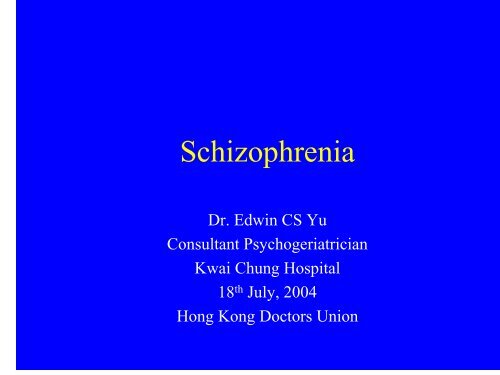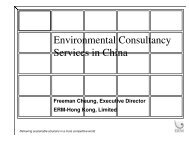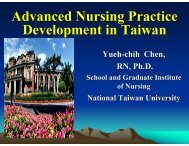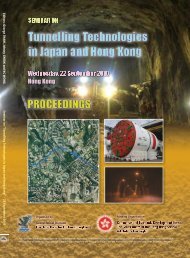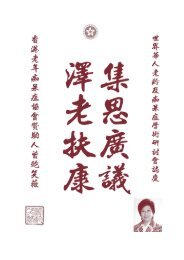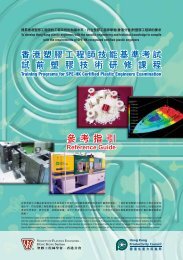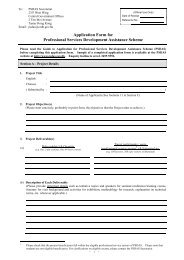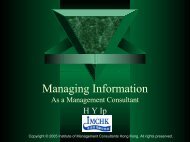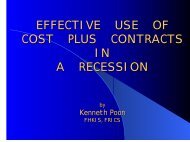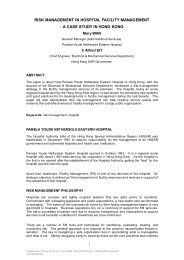Schneider's first rank symptoms \(1\)
Schneider's first rank symptoms \(1\)
Schneider's first rank symptoms \(1\)
You also want an ePaper? Increase the reach of your titles
YUMPU automatically turns print PDFs into web optimized ePapers that Google loves.
Schizophrenia<br />
Dr. Edwin CS Yu<br />
Consultant Psychogeriatrician<br />
Kwai Chung Hospital<br />
18 th July, 2004<br />
Hong Kong Doctors Union
Epidemiology<br />
• Incidence : 15-30 new cases per 100,000<br />
population per year<br />
• Lifetime risk : 1%<br />
• Age of onset : usually 15-45 y.o., earlier in<br />
men than in women<br />
• Higher incidence in those not married<br />
• More common in social classes IV and V<br />
• Urban higher than rural
Aetiology (1)<br />
Genetics:<br />
Relationship<br />
Lifetime expectancy rate<br />
Parents 6 %<br />
All siblings 10 %<br />
Siblings (when 1 parent has schiz) 17 %<br />
Children 13 %<br />
Children (when both parents have schiz) 46 %<br />
Grandchildren 4 %<br />
Uncles, aunts, nephews and nieces 3 %
Aetiology (2)<br />
Prenatal factors:<br />
• Winter births<br />
• Prenatal infection<br />
• Minor physical abnormalities e.g. low-set ears,<br />
greater distance between eyes, single transverse<br />
palmar crease<br />
• Obstetric complications
Aetiology (3)<br />
Personality:<br />
• Schizotypal personality disorder<br />
• Eccentricity<br />
• Affect constriction<br />
• Excessive social anxiety
Aetiology (4)<br />
Social factors:<br />
• Life events in the 3 weeks before relapse<br />
• Families with high expressed emotions (critical<br />
comments, over-involvement)<br />
• Poverty of the social milieu
Clinical picture
Schneider’s <strong>first</strong> <strong>rank</strong> <strong>symptoms</strong><br />
(1)<br />
• Voices commenting<br />
• Voices arguing or discussing<br />
• Audible thoughts<br />
• Thought broadcast<br />
• Thought withdrawal<br />
• Thought insertion
Schneider’s <strong>first</strong> <strong>rank</strong> <strong>symptoms</strong><br />
(2)<br />
• Made will<br />
• Made acts<br />
• Made affect<br />
• Somatic passivity<br />
• Delusional perception
Schneider’s <strong>first</strong> <strong>rank</strong> <strong>symptoms</strong><br />
(3)<br />
• Not unique to schizophrenia<br />
• 10-15% of manic-depressive psychosis<br />
• Also in organic brain conditions
Hallucinations<br />
Auditory hallucinations:<br />
• Voices usually harsh, critical or frightening<br />
• Mood incongruent<br />
• Behavior: Whispering or looking around<br />
Olfactory hallucinations<br />
Somatic hallucinations<br />
Visual hallucinations
Delusions (1)<br />
• Primary delusions: defy logic, arise<br />
suddenly and without any foundation<br />
• Delusions of alien control of thought,<br />
action, will, affect and somatic function<br />
• Delusional mood<br />
• Delusional memories
Delusions (2)<br />
• Delusion of persecution<br />
• Delusion of reference<br />
• Grandiose delusions<br />
• Nihilistic delusions<br />
• Delusional system
Disorders of thought<br />
Unstable goal<br />
• Tangentiality<br />
• Distractability<br />
• Perseveration<br />
Idiosyncratic thought and language<br />
Weakening of goal<br />
• Empty speech<br />
• Generalisation<br />
Disorders of flow<br />
• Poverty of speech<br />
• Pressure of speech<br />
• Blocking
Disorders of affect<br />
• Blunted affect<br />
• Incongruous affect<br />
• Depression<br />
• Prodromal phase<br />
• Acute phase<br />
• Chronic phase: 15-25%<br />
• Anhedonia
Positive <strong>symptoms</strong><br />
•Acute<br />
•Delusions<br />
• Hallucinations<br />
• Formal thought disorder
Negative <strong>symptoms</strong><br />
• Chronic<br />
• Poverty of speech<br />
• Blunted affect<br />
• Poor volition<br />
• Decreased spontaneous movements
Course and prognosis
Onset<br />
• Variable modes of onset<br />
• Insidious:<br />
• Abrupt:<br />
• subtle abnormalities in childhood or adolescence<br />
• often follows a stressful experience<br />
• Prodromal phase:<br />
• subtle alteration of behavior, preoccupation, social<br />
withdrawal
Age of onset<br />
• Male:<br />
• Female:<br />
• Rises rapidly through adolescence to a peak at 22,<br />
followed by a steady decrease so that onset after 40<br />
is rare<br />
• Rises through adolescence, but the peak is later,<br />
distribution is broader, and an appreciable risk<br />
persists into middle age
Good prognostic factors<br />
• Evidence of schizoaffective features<br />
• Marked mood disturbance at onset<br />
• Family history of affective illness<br />
• Outcome is better in females than in males<br />
• Outcome is better in less developed<br />
countries
Poor prognostic factors<br />
• Poor premorbid adjustment<br />
• Insidious onset<br />
• Onset in adolescence<br />
• Marked cognitive impairment<br />
• Enlargement of cerebral ventricles
Long-term outcome<br />
• Tendency to resolve eventually in many<br />
cases, though the time-scale of<br />
improvement can be several decades<br />
• In patients who have not yet recovered after<br />
several decades, acute exacerbations are<br />
less common than in earlier years. A large<br />
number exhibit a defect state
10% commit suicide<br />
• More likely if:<br />
• Early in illness<br />
• Males<br />
• Younger<br />
• Chronic illness, relapse and remissions<br />
• Unemployed<br />
• High educational attainment prior to onset<br />
• Akathisia<br />
• Abrupt stoppage of drugs<br />
• Recent discharge from in-patient care<br />
• Paranoid 3x more likely than non-paranoid
Post-schizophrenic depression (1)<br />
• Majority of schizophrenia patients are likely<br />
to experience depressive features at some<br />
point<br />
• Directly related to the illness rather than<br />
pharmacogenic<br />
• 25% suffers post-schizophrenic depression,<br />
may be the major reason for readmission
Post-schizophrenic depression (2)<br />
• Studies demonstrated the benefits of<br />
tricyclic antidepressants<br />
• Value of new antidepressants await<br />
clarification<br />
• May be a result of demoralisation and<br />
hopelessness from appreciation of the<br />
nature of the illness and its consequences
Drug treatment of schizophrenia<br />
Neuroleptics = Antipsychotics<br />
Typical vs Atypical<br />
Oral vs Depot
Drug treatment<br />
• Positive <strong>symptoms</strong> respond better than<br />
negative <strong>symptoms</strong><br />
• 5-25% of schizophrenics unresponsive to<br />
conventional neuroleptics<br />
• 5-10% intolerant because of neurological<br />
side effects<br />
• 40-60% non-compliant
Drug treatment<br />
• Continuous therapy is superior to<br />
intermittent treatment<br />
• Of the patients who stop medication, 60-<br />
70% relapse within 1 year, and 85% within<br />
2 years, compared to 10-30% of those who<br />
continue on active medication
Typical antipsychotics<br />
• Haldol (haloperidol)<br />
• Largactil (chlorpromazine)<br />
• Melleril (thioridazine)<br />
• Stelazine (trifluoperazine)<br />
• Orap (pimozide)<br />
• Fluanxol (flupentixol)<br />
• Neulactil (pericyazine)<br />
• Moban (molindone)
Typical antipsychotics<br />
• Choose the antipsychotic according to the<br />
side effect profile<br />
•Examples:<br />
• For more sedative effects, choose Largactil,<br />
Melleril, or Neulactil<br />
• If patient has cardiovascular diseases, avoid<br />
Largactil, Melleril and Orap<br />
• For high potency drugs, choose Haldol, Stelazine, or<br />
Orap; but beware of extrapyrimidal S/E
Atypical antipsychotics<br />
• Clozaril (clozapine)<br />
• Dogmatil (sulpiride)<br />
• Risperdal (risperidone)<br />
• Zyprexa (olanzapine)<br />
• Seroquel (quetiapine)<br />
• Zeldox (ziprasodone)<br />
• Solian (amisulpiride)
Atypical antipsychotics<br />
• Most of them are the new generation<br />
antipsychotics, with more favorable side<br />
effect profile compared with the typical<br />
antipsychotics<br />
• Exceptions are clozapine and sulpiride,<br />
which are from the old generation but with<br />
a different side effect profile
Atypical antipsychotics<br />
• More favourable side effect profile:<br />
• Less extrapyramidal side effects (EPS)<br />
• Less tardive dyskinesia (TD)<br />
• Less anticholinergic side effects<br />
• Less sedation<br />
• Less postural hypotension and less cardiotoxicity
Clozapine<br />
• Clozapine is a unique drug as it is the drug of<br />
choice for resistant schizophrenia<br />
• Side effect of agranulocytosis (incidence of 0.8%<br />
at 12 months, with a peak risk in the 3 rd month)<br />
• WCC monitoring mandatory: weekly for the <strong>first</strong><br />
18 weeks then Q4weeks<br />
• Sedation and antimuscarinic side effects<br />
• Less EPS
Oral vs Depot<br />
• Oral:<br />
•Depot:<br />
• First-pass metabolism<br />
• Variable bioavailability<br />
• Solves the problem of drug compliance<br />
• No <strong>first</strong>-pass effect<br />
• Decrease relapse rate<br />
• Once every 4 weeks (2 weeks for Risperdal Consta)
Depot antipsychotics<br />
• Modecate depot (fluphenazine decanoate)<br />
• Clopixol depot (zuclopenthixol decanoate)<br />
• Fluanxol depot (flupentixol decanoate)<br />
• Haldol depot (haloperidol decanoas)<br />
• Risperdal Consta
Oral liquid preparations<br />
• Haldol drops<br />
• Risperdal drops<br />
• Useful for elderly patients with swallowing<br />
difficulties
As general practitioners, it is<br />
important to recognize the side<br />
effects of antipsychotics and refer<br />
back to psychiatrist accordingly.
Non-neurological S/E (1)<br />
Adverse<br />
Reaction<br />
Frequency<br />
Comment<br />
General<br />
Sedation<br />
“Torpor” (Ataraxy)<br />
Dry mouth<br />
++<br />
+++<br />
+<br />
Esp. with low potency drugs<br />
Blurred vision<br />
Constipation<br />
Urinary difficulties<br />
Impaired sexual<br />
function<br />
Weight gain<br />
+<br />
+<br />
+<br />
+<br />
+++<br />
Conventionally viewed as<br />
peripheral anticholinergic effects.<br />
Some probably include adrenergic<br />
actions<br />
May have endocrine component<br />
Cardiovascular<br />
Incr. Heart rate<br />
Hypotension<br />
+++<br />
++<br />
Not clinically significant<br />
Can be fatal – caution with early<br />
exposure to low potency drugs<br />
ECG changes<br />
++<br />
Quinidine-like effect : rarely<br />
causes ventricular<br />
tachyarrhythmias particularly with<br />
thioridazine
Non-neurological S/E (2)<br />
Adverse<br />
Reaction<br />
Frequency<br />
Comment<br />
Endocrine<br />
Hyperprolactinaemia<br />
+++<br />
Universal effect<br />
(except clozapine)<br />
- Galactorrhoea<br />
- Hyper/hypoglycaemia<br />
Gynaecomastia<br />
Hyper/hypoglycaemia<br />
Inappropriate ADH<br />
Rare<br />
+<br />
Rare<br />
Rare<br />
Rare<br />
Rarely clinically significant<br />
Hepatic<br />
Function<br />
Impaired liver<br />
++<br />
Transient changes common. Jaundice<br />
esp. with chlorpromazine<br />
Dermatologic<br />
al<br />
Skin rashes<br />
-Erythematous<br />
-Urticarial<br />
-Contact<br />
Photosensitivity<br />
Pigmentation<br />
++<br />
++<br />
Rare<br />
Rare<br />
++<br />
? Rare<br />
Especially with chlorpromazine<br />
Can result in serious burning. Temp.<br />
less important than brightness<br />
Infrequently reported nowadays
Non-neurological S/E (3)<br />
Adverse<br />
Reaction<br />
Frequency<br />
Comment<br />
Haemato<br />
logical<br />
Neutropenia<br />
Agranulocytosis<br />
Rare<br />
Rare<br />
But note – with clozapine :reversible<br />
Neutropenia (~2%) Can progress to<br />
agranulocytosis if drug maintained<br />
Thrombocytopenia<br />
Haemolytic<br />
anaemia<br />
V. Rare<br />
V. Rare<br />
Ophthalmic<br />
Lenticular deposits<br />
Pigmentary<br />
retinopathy<br />
Rare<br />
Reversible with early detection<br />
High dose, long-term thioridazine<br />
only
Acute dystonia (1)<br />
Presentation<br />
Affect<br />
Neck<br />
Tongue<br />
Jaw<br />
Retrocollis<br />
Torticollis<br />
Laterocollis<br />
Anterocollis<br />
Rotation<br />
Protrusion<br />
Retraction<br />
Forced opening<br />
Lateral deviation<br />
Trismus
Acute dystonia (2)<br />
Presentation<br />
Extraocular<br />
Trunk<br />
Limbs<br />
Upward (+- lateral) deviation<br />
Scoliosis<br />
Opisthotonos<br />
Affect<br />
Full range of dystonic postures<br />
-Hyperpronation of arms<br />
-Wrist flexion<br />
-Metacarpal-phalangeal flexion/extension<br />
-Extension of lower limbs<br />
-Adductor spasm<br />
-Plantarflexion-inversion<br />
-Dorsiflexion-eversion
Parkinsonism (1)<br />
Feature<br />
Posture : Flexion<br />
Hypomimia<br />
Sialorrhoea<br />
Seborrhoea<br />
Loss of background<br />
body movement<br />
Loss of pendular arm<br />
swing<br />
Tremor : resting<br />
: action / postural<br />
In drug related disorder slight hyper-extension of<br />
spine more common<br />
“Masked” expression / loss of facial contours<br />
May be failure to swallow rather than excessive<br />
production – drooling<br />
Decreased gesture and interactive postural<br />
movements<br />
Early, sensitive sign<br />
Comment<br />
~ 6 Hz relatively uncommon, late sign<br />
~ 15-20 Hz common, early sign
Parkinsonism (2)<br />
Rigidity<br />
Instability<br />
Feature<br />
Loss of dexterity<br />
Micrographia<br />
Impairment of speech<br />
Impaired initiation of<br />
voluntary activity<br />
Disturbance of gait<br />
Rarely marked<br />
Comment<br />
May impair independent living/self-care.<br />
Caution with driving/operating machinery<br />
Reduction in vertical and horizontal size<br />
Loss of pitch and power<br />
-soft monotonous speech<br />
-inarticulate<br />
Reduced length and height of step<br />
- shuffling/festination
Akathisia<br />
Feature<br />
Anxious, tense expression<br />
Restlessness on sitting<br />
Inability to sit<br />
Inability to stand still<br />
Comment<br />
Hands fidgety<br />
“Sitting up” repeatedly<br />
Side to side movement<br />
Rocking – backwards/forwards<br />
Swinging legs<br />
Crossing / uncrossing legs<br />
Standing (e.g. in mid-sentence)<br />
Shifting weight from foot to foot<br />
Pacing (with “driven” quality)
Tardive Dyskinesia (1)<br />
Presentation<br />
Tongue<br />
Lips<br />
Effect<br />
No displacement<br />
“Vermicular” movements<br />
Twisting : horizontal/longitudinal axis<br />
Displacement<br />
Sweeping buccal surface : “bon bon” sign<br />
Irregular jerky protrusion : “Fly catcher” sign<br />
“Tromboning” on voluntary protrusion<br />
Puckering<br />
Pouting<br />
Puffing<br />
Smacking<br />
Lateral retraction : “bridling”
Tardive Dyskinesia (2)<br />
Presentation<br />
Jaw<br />
Facial expression<br />
Neck<br />
Truck<br />
Effect<br />
Mouth opening<br />
Clenching (“Trismus”)<br />
Grinding (“Bruxism”)<br />
Forward/lateral protrusion<br />
Tics<br />
Grimacing<br />
Blepharoclonus<br />
Blepharospasm<br />
Irregular eyebrow elevation<br />
Frowning<br />
Torti-/Retro-/Latero-/Antero-Collis<br />
(Kinetic (spasmodic) or static)<br />
Unilateral dystonia : “Pisa syndrome”<br />
Hyperextension of spine (bilateral dystonia)<br />
Axial hyperkinesis : “copulatory” movements
Tardive Dyskinesia (3)<br />
Presentation<br />
Upper limbs<br />
Oropharynx<br />
Diaphragm/<br />
intercostals<br />
“Restless” legs<br />
Squirming : “outsplaying” of toes<br />
Ankle rotation<br />
Eversion/inversion<br />
Stamping<br />
Dysphagia<br />
Effect<br />
Irregular respiration/grunting


